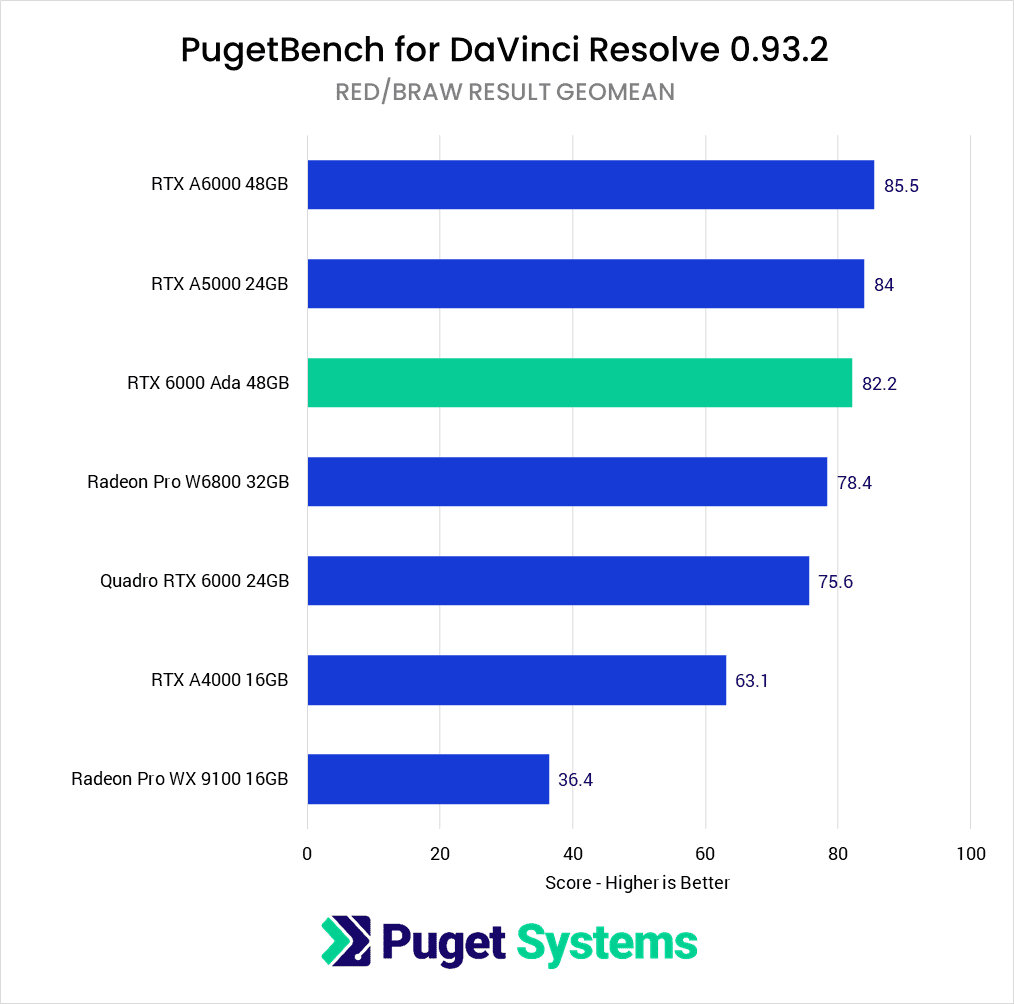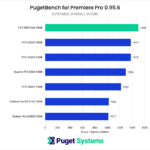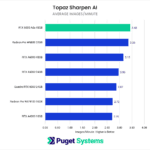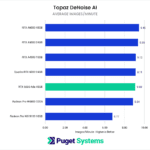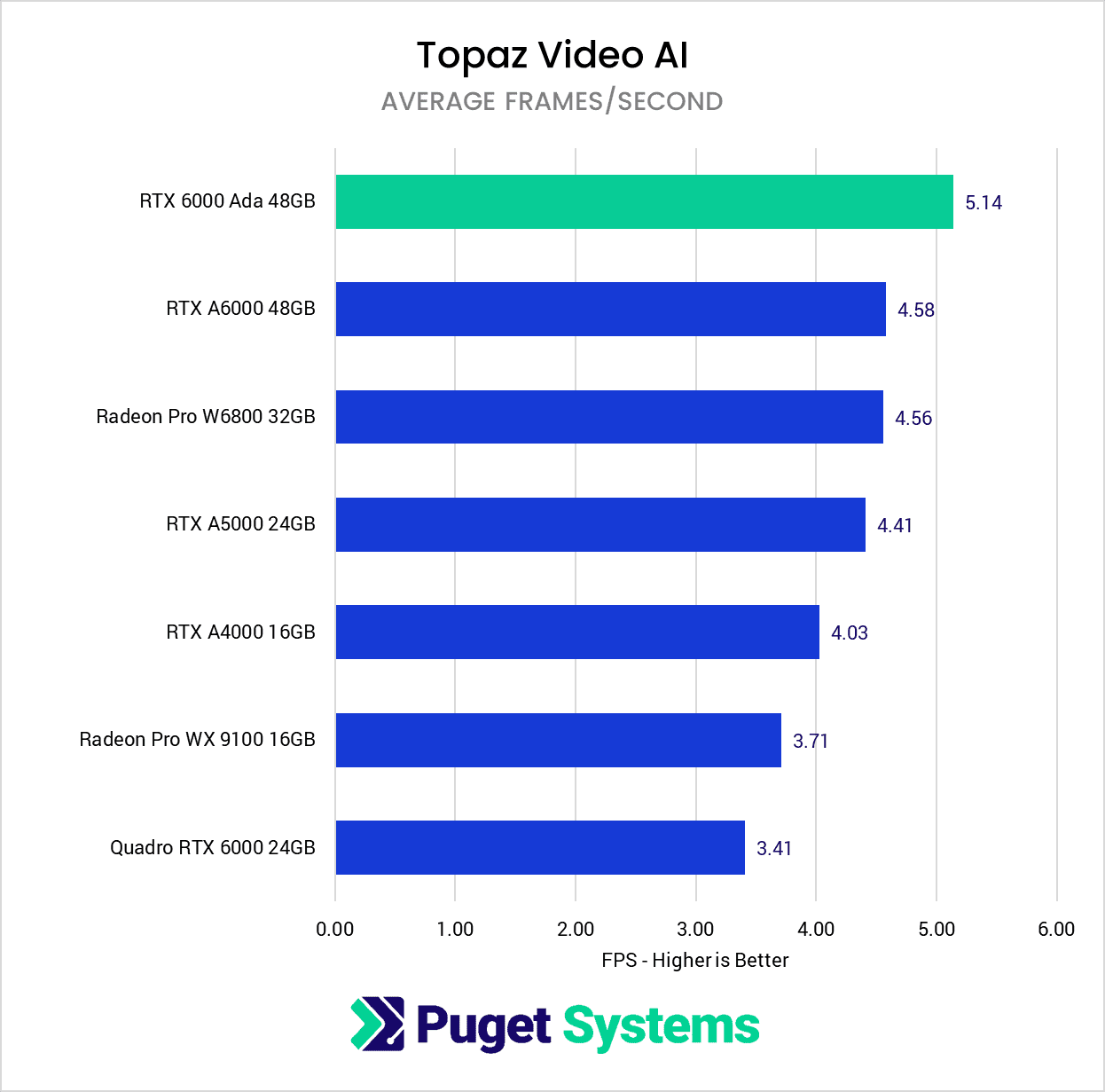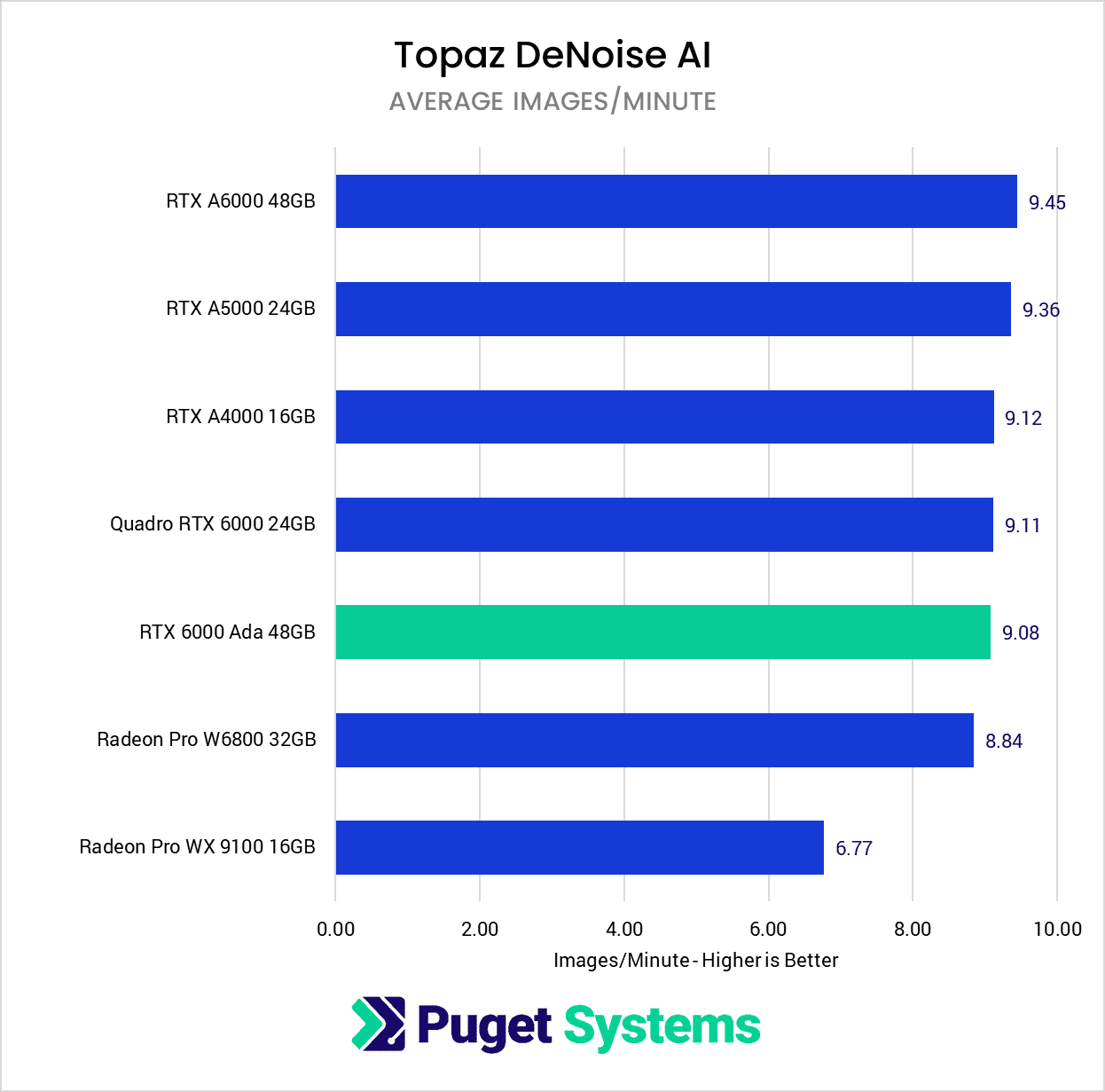Table of Contents

Introduction
With the RTX 6000 Ada, NVIDIA is releasing the first of their “Ada Lovelace” professional GPUs. This GPU is a powerhouse that should power through even the toughest workloads, featuring 48GB of VRAM and up to a staggering 91.1 TFLOPS of single-precision performance.
This class of GPU is typically priced much higher than their consumer-focused GeForce counterparts, but are intended for very different types of workflows. Where GeForce is about performance first and foremost, the NVIDIA RTX (formerly Quadro) cards are more about stability, reliability, and robustness. NVIDIA accomplishes this in many ways, including running them at slightly lower wattages and clock speeds, as well as enhanced driver testing and verification. This class of cards also typically features more VRAM, with the top models supporting 48 GB of VRAM – double what you can currently get from a GeForce GPU.
We recommend checking out the NVIDIA Professional GPU product page to see the full specs for NVIDIA’s RTX GPUs. But at a glance, here are what we consider to be the most critical specs alongside a range of other cards from NVIDIA and AMD:
| GPU | VRAM | CUDA/Stream Cores | Single-Precision Performance | Power | Launch Date | MSRP |
|---|---|---|---|---|---|---|
| RTX A4000 | 16GB | 6,144 | 19.2 TFLOPS | 140W | April 2021 | $1,000 |
| Radeon PRO WX9100 | 16GB | 4,096 | 12.3 TFLOPS | 230W | Aug 2017 | $1,600 |
| Radeon PRO W6800 | 32GB | 3,840 | 17.83 TFOPS | 250W | June 2021 | $2,250 |
| RTX A5000 | 24GB | 8,192 | 27.8 TFLOPS | 230W | April 2021 | $2,500 |
| RTX A6000 | 48GB | 10,752 | 38.7 TFLOPS | 300W | Oct 2020 | $4,650 |
| RTX 6000 Ada | 48GB | 18,176 | 91.1 TFLOPS | 300W | Dec 2022 | $6,800 |
| Quadro RTX 6000 | 24GB | 4,608 | 16.3 TFLOPS | 295W | Aug 2018 | $7,000 |
For the new NVIDIA RTX 6000 Ada, we are getting a fairly hefty price increase over the RTX A6000, almost back to the level we were at in 2018 with the RTX 6000. Be aware, however, that this MSRP pricing should be taken worth a grain of salt. Professional cards tend to have a wide swing in pricing depending on where they are purchased, as they are typically provided as a component inside an entire workstation and not as an individual part. Purchasing as a stand-alone part is often quite a bit more expensive than what you would pay if included in a prebuilt workstation, and is subject to wide swings in pricing.
While we listed the core specs in the table above, one thing not listed is the fact that the RTX 6000 Ada is dropping support for NVLINK. This won’t affect most users, but it can significantly impact specific workflows such as GPU rendering, virtual production, and AI/ML. If NVLINK is necessary for you, you will want to stick with the NVIDIA RTX A6000, although we are hoping that the increased performance from the RTX 6000 Ada will mean that a single 6000 Ada will be able to take over for a pair of RTX A6000 GPUs – at least in terms of raw performance.
Speaking of performance, the RTX 6000 Ada looks great on paper, with single-precision performance that is more than 2x higher than the previous generation RTX A6000. This seems like a massive increase, and we are very interested to see if it aligns with real-world performance in various content creation workflows.
While this post is focused on the professional-class GPUs from NVIDIA and AMD, the test platform and benchmarks are identical to those used in our recent NVIDIA GeForce 40 Series vs AMD Radeon 7000 for Content Creation article. Doing a price-to-performance comparison between consumer and professional GPUs is not entirely valid (it is like comparing the top speed of a pickup truck to a sports car), but looking at the results in both articles can give you an idea of the performance side of the equation. Just be sure to also factor in how much money it may cost you if your system bluescreens or has any other issues due to a failed GPU or broken driver.
Test Setup
Test Platform
Benchmark Software
| DaVinci Resolve 18.1.2 PugetBench for DaVinci Resolve 0.93.2 |
| Premiere Pro 23.1.0 PugetBench for Premiere Pro 0.95.6 |
| Topaz AI Suite (Video AI 3.0.11.0, Gigapixel AI 6.2.2, DeNoise AI 3.7.0, Sharpen AI 4.1.0) |
| Unreal Engine 4.26 |
| OctaneBench 2020.1.5 |
| Blender 3.4.0 |
| V-Ray 5.02.00 |
| RedShift 3.5.08 |
To see how the NVIDIA RTX 6000 Ada performs, we will primarily compare it to the previous generation, including the RTX A6000, A5000, and A4000. In addition, we will also go two generations back to see how it compares to the Quadro RTX 6000 for additional context. As a comparison to AMD, we are including the top Radeon PRO models from the last two generations: the Radeon PRO W6800 and WX 9100. While these GPUs are less than half the cost of the RTX 6000 Ada, they currently represent the highest-end GPUs from AMD.
It is worth noting that NVIDIA does have additional models in their RTX A-series family, including the RTX A5500 and RTX A4500. However, those models are not as common, so we are leaving them out of this article.
The test system we will be using is one of the fastest platforms currently available for most of the applications we are testing and is built around the AMD Threadripper Pro 5975WX to minimize any potential CPU bottlenecks. We will use many of our PugetBench series of benchmarks that can take advantage of more powerful GPUs. Most of these benchmarks include the ability to upload the results to our online database, so if you want to know how your system compares, you can download and run the benchmark yourself. Several GPU rendering benchmarks supplement our testing to show off the GPU rendering performance of these cards.
Video Editing: DaVinci Resolve Studio
For our first look at the NVIDIA RTX 6000 Ada 48GB, we will examine performance in DaVinci Resolve Studio. More so than any other NLE (Non-Linear Editor) currently on the market, Resolve can utilize high-end GPUs and even multi-GPU setups. The three primary areas the GPU is used for in this type of application are processing GPU effects, H.264/HEVC decoding/encoding, and debayering (and optionally decoding) RAW media.
To start, however, we want to look at the Overall Score, which combines everything we test for Resolve. This is often a good indicator of what kind of relative performance a “typical” (if such a thing exists) Resolve user may see with different hardware, but it is less focused on the GPU as it includes many tasks that are more CPU focused. In terms of overall performance, the RTX 6000 Ada performs well, topping our charts and beating the previous generation RTX A6000 by 12%. This amount of performance also allows it to be almost 40% faster than the AMD Radeon PRO W6800, although keep in mind that the new RTX 6000 Ada is more expensive than either of these cards ($6,800 vs $4,650 for the RTX A6000, or $2,250 for the W6800)
When we switch to the most GPU-focused of our tests (GPU-accelerated effects in chart #2), the RTX 6000 Ada truly shines. Here, the RTX 6000 Ada is 50% faster than the RTA A6000, or just shy of 2x faster than the AMD Radeon PRO W6800. This makes it about 2x faster than the two-generation old Quadro RTX 6000. If GPU-accelerated effects are a bottleneck in your workflow, the RTX 6000 Ada can give you a massive performance boost – especially if you opt to get multiple cards as this is where Resolve scales with multiple GPUs.
Decoding and encoding of interframe codecs like H.264 and HEVC can also be handled by the GPU, although these tasks use specific decoding/encoding chips on the card, rather than the normal CUDA cores. Because of this, performance tends to be similar across multiple GPUs of the same family. Still, as you can see in the second chart, the new RTX 6000 Ada is a great 17% faster than the RTX A6000, and a massive 80% faster than AMD’s fastest professional GPU – the Radeon PRO W6800.
Last up is performance when working with RAW codecs like RED and BRAW. We will note here that there are multiple ways to use the GPU for this, with the default being to use it to handle the “debayering” step, turning the raw sensor data into a usable video. There is a separate “decoding” step as well, which by default is handled by the CPU. Resolve does have the option to use the GPU for both steps, but since that is not the default behavior, we are currently testing with only GPU debayering.
However, as you can see in chart #3, there isn’t much difference in GPU performance for RAW media once you get up to a mid-range GPU, as the new RTX 6000 Ada is about on par with the previous generation RTX A6000 and A5000. Given how fast GPUs are becoming, we are considering switching our testing to test in debayer+decoding mode, as Blackmagic seems slow to update their defaults to match the performance capabilities of modern GPUs.
Overall, the RTX 6000 Ada is excellent for DaVinci Resolve. Performance across the board is higher than the previous generation, and for GPU effects in particular, it is 50% faster than the RTX A6000. It does come at a price premium over the previous generation, but if GPU performance is your bottleneck, it could be a worthwhile investment. Another consideration is that it is a dual-slot GPU, so you can use 3 (or possibly 4) cards in a single system, whereas with a consumer-level card like the GeForce RTX 4090, you are limited to just one or two cards. That sort of configuration is going to be pricey, but at that level of workflow, the hardware cost is often not nearly as important as the amount of time that can be saved.
Full Analysis: DaVinci Resolve Studio: NVIDIA RTX 6000 Ada Performance
Video Editing: Adobe Premiere Pro
Adobe Premiere Pro does not utilize the GPU quite as much as DaVinci Resolve (and effectively doesn’t take advantage of multi-GPU setups at all), but having a strong GPU can still make an impact depending on your workflow.
Once again, we will start with the Overall Score from our benchmark, where the new NVIDIA RTX 6000 Ada takes the top spot. It is less than 10% faster than the previous generation RTX A6000, but does hold a nice ~50% lead over the AMD Radeon PRO W6800. However, part of the reason the Radeon PRO W6800 scores are so low is due to what appears to be a broken driver, so we expect this gap to close in the future. We will expand on this later.
Just like with DaVinci Resolve, the Overall Score includes several CPU-limited tasks, so we want to drill down into GPU-accelerated effects like Lumetri Color, most blurs, etc. (chart #2). For these tasks, the RTX 6000 Ada does very well, beating the RTX A6000 by a solid 24%, and the Radeon PRO W6800 by 43%.
On chart #3, we are again looking at the geometric mean of the H.264 and HEVC results. This was an area where AMD has made massive improvements with their consumer Radeon 7000 Series cards, but the Radeon PRO W6800 is still based on the older architecture, and also has a massive driver bug that results in extremely poor performance with 8K HEVC media. We have reported this issue to AMD, and they are currently investigating the cause. We will update this article with more information when available, but for now, the W6800 gets a massive hit to the H.264/HEVC score due to this bug.
Focusing back on the new RTX 6000 Ada, it is only marginally faster than the previous generation for H.264/HEVC, with the difference between it and the RTX A6000 (and A5000) being close enough that we would consider it to be within the margin of error. This test is usually more about the NVDEC/NVENC decoder/encoder chips on the GPU, rather than the raw compute performance of the card, but we will note that the new RTX 6000 Ada should be much faster than what we are seeing. In fact, in our DaVinci Resolve testing, the RTX 6000 Ada was 17% faster than the RTX A6000 for similar tasks, so the issue here is likely Premiere Pro lacking support for some of the newer decoding/encoding features found in the RTX 6000 Ada.
Lastly, chart #4 shows the performance when debayering RED RAW footage. This is an area where we are starting to become CPU bottlenecked, however, as Premiere Pro currently only supports debayering of RED media, and keeps the decoding portion of the process on the CPU. Because of this, there isn’t going to be a massive difference in GPU performance once you get above a mid-range NVIDIA GPU.
Full Analysis: Adobe Premiere Pro: NVIDIA RTX 6000 Ada Performance
Video/Photo AI Enhancement: Topaz AI Suite
Topaz AI is fairly new to our testing, and we highly recommend checking out our in-depth article for information on what, and how, we are testing each of the applications in the Topaz AI suite. One of the big things to know about Topaz AI is that GPU performance is highly dependent on which application you are looking at. Video AI, Gigapixel AI, Sharpen AI, and DeNoise AI are the four we focus our testing on now, and each behaves very differently.
The Overall Score (chart #1) is the geometric mean of each app-specific score, but the performance per application shifts so much that if you use Topaz AI, we highly recommend looking at the individual results for the application you use. The RTX 6000 Ada tops the Overall Score chart, but it doesn’t take the top spot for each of the individual applications.
Topaz Video AI (chart #2) is the one we tend to get the most direct questions about, and for this application, the new RTX 6000 Ada is a small 12% faster than the previous generation RTX A6000, and only 14% faster than the Radeon PRO W6800. Considering that the W6800 is a third the price of the RTX 6000 Ada, that is a pretty small performance benefit given the huge difference in cost.
Beyond the Video AI application, there are also three photo-based applications. Topaz Gigapixel AI (chart #3) and Sharpen AI (chart #4) has the new RTX 6000 Ada less than 10% faster than the RTX A6000. Interestingly, AMD doesn’t fare well in Gigapixel AI, with the RTX 6000 Ada scoring 60% faster, but does great in Sharpen AI, performing on par with NVIDIA.
The final application we are currently testing is DeNoise AI (chart #5); although the GPU doesn’t make as much of a difference for that specific app – likely due to it taking less time to do the actual AI processing on the GPU, resulting in the CPU becoming a larger bottleneck overall. Because of this, we see very little performance difference between most of the cards we tested. The new RTX 6000 Ada under-performed a bit, but all of the RTX cards were within a few percent, so we are likely just looking at the margin of error for Topaz Denoise AI.
Full Analysis: Topaz AI Suite: NVIDIA RTX 6000 Ada Performance
Game Dev/Virtual Production: Unreal Engine
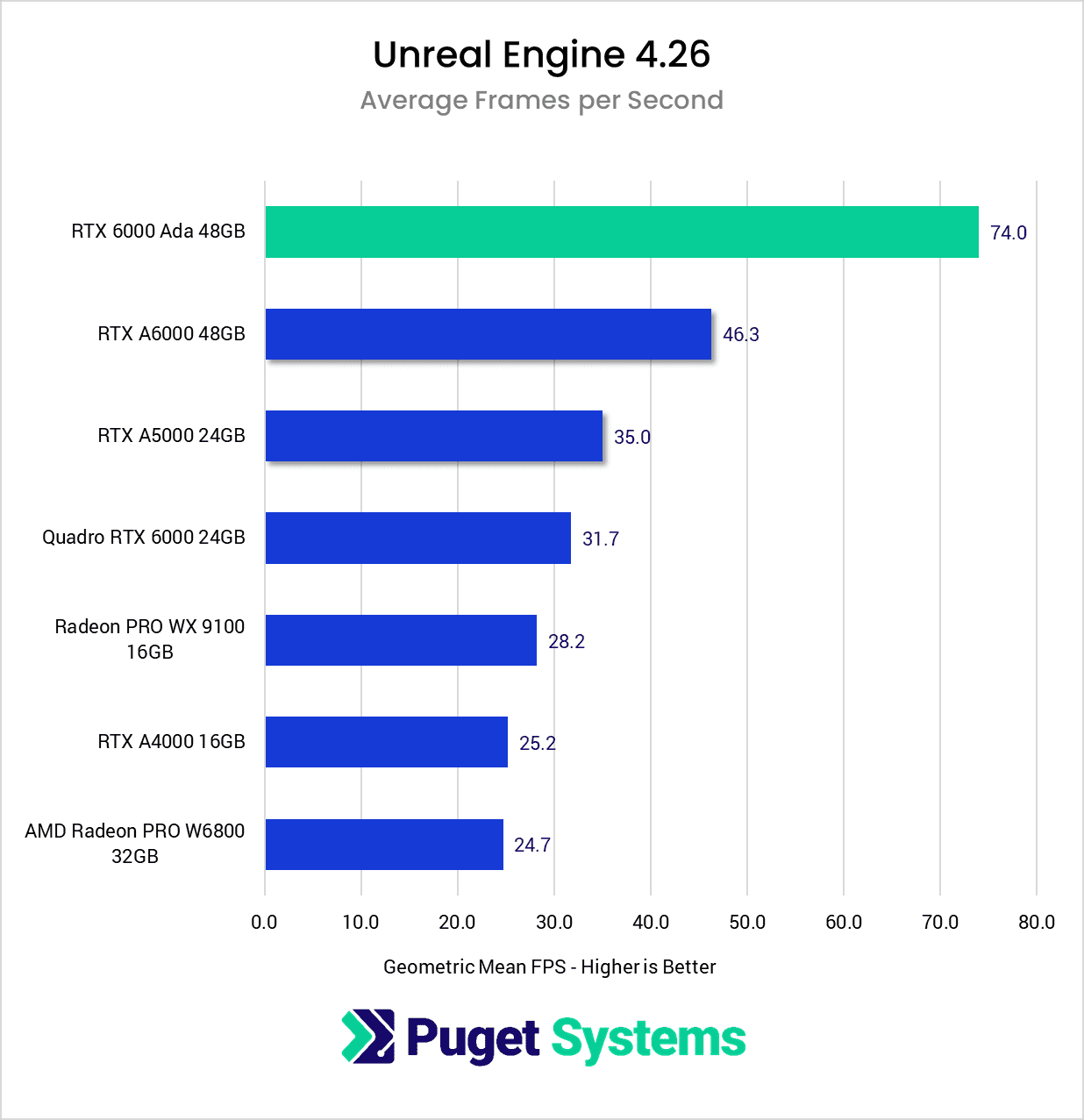
In Unreal Engine, we test a variety of scenes with and without ray tracing to get a general picture of how different workflows will benefit from these new GPUs. The RTX 6000 Ada is by far the overall winner, generating 60% more frames per second than the previous generation RTX A6000. While most professional workflows, be it Virtual Production or Game Development, are not looking for super high frame rates for their day-to-day work, this can also be translated into being able to put more geometry and effects on screen while still maintaining their desired framerate.
The lack of NVLink will disappoint some Virtual Production users who dedicate one GPU to the inner frustum, and the other to the outer. Technically this can still be done over PCIe, but the bandwidth available is cut dramatically compared to NVLink. Higher resolutions, frame rates, or bit depth can quickly put you past that bandwidth, dragging performance down.
AMD’s GPUs may not gain much ground in the Virtual Production fields, but their strong rasterized performance, plus their large 32GB of VRAM, will make for interesting options in the Game Development space.
Full Analysis: Unreal Engine: NVIDIA RTX 6000 Ada Performance
GPU Rendering: V-Ray

GPU rendering is, in many ways, the poster child for the RTX 6000 Ada, with a near doubling of the score of the RTX A6000. These GPUs are also extremely strong in multi-GPU configurations, with up to three in a workstation is possible, whereas consumer GPUs are often limited to just two. For those looking for the best-performing GPU for rendering, the RTX 6000 Ada is hands down the best option.
Full Analysis: GPU Rendering: NVIDIA RTX 6000 Ada Performance
GPU Rendering: OctaneRender

As we saw in V-Ray, the RTX 6000 Ada does fantastic in this GPU rendering engine. With the RTX 6000 Ada coming in at 83% faster than the RTX A6000, there is no comparison for GPU rendering hardware.
Full Analysis: GPU Rendering: NVIDIA RTX 6000 Ada Performance
GPU Rendering: Redshift

Using the built-in Redshift Benchmark echoes what we’ve seen with the other GPU rendering benchmarks. The RTX 6000 Ada was able to complete the render in 87 seconds, 83% faster than the RTX A6000’s 159 seconds. The Quadro RTX 6000 posted a time of 242 seconds, or three times slower than the new RTX 6000 Ada. While not shown in the chart above, we were also able to test dual RTX 6000 Ada, which only took 45 seconds to render the frame. We will have more data about multi-GPU rendering soon.
Full Analysis: GPU Rendering: NVIDIA RTX 6000 Ada Performance
GPU Rendering: Blender

Blender is one of the few GPU renderers that supports both NVIDIA and AMD. NVIDIA has long dominated the rendering space, and their CUDA and Optix APIs have made for some very powerful GPU-based renderers. But for Blender, we have the option to use either NVIDIA, AMD, or even Intel GPUs.
The RTX 6000 Ada has the biggest gains in Blender. It scored 117% higher than the RTX A6000, and three and a half times the Quadro RTX 6000. The AMD Radeon PRO W6800 falls way short of the RTX 6000 Ada, but also costs significantly less. It is great to see AMD on these charts, but they have a lot of ground to make up in the rendering space.
Full Analysis: GPU Rendering: NVIDIA RTX 6000 Ada Performance
How Well Does the NVIDIA RTX 6000 Ada Perform for Content Creation?
NVIDIA has long been our go-to choice for most content creation workflows, but many users opt to go with the consumer-level GeForce line rather than the processional NVIDIA RTX cards. For many users, the advantages you get from the pro cards (mostly stability and VRAM capacity) is simply not worth the higher cost, making GeForce a more common choice.
When time is money, and any system downtime costs thousands of dollars, however, that is where the professional NVIDIA RTX (and AMD Radeon PRO) line comes in. Not only do these cards tend to be more stable on a hardware level, but their drivers also go through significantly more robust testing and validation for professional workloads. Whether it is a video editing system being used for a major blockbuster movie, or a system powering a massive virtual production LED wall, the additional cost for a professional GPU is often a drop in the bucket compared to everything else. And even for more modest use cases, the cost can sometimes be justified as part of an ROI (return on investment) calculation.
With all that said, the new NVIDIA RTX 6000 Ada 48GB performs very well overall, although the highest cost relative to the previous generation NVIDIA RTX A6000 48GB is going to mean that it isn’t always the best pick.
Starting with video editing and content creation, the big area where the RTX 6000 Ada does well is for GPU-accelerated effects in DaVinci Resolve Studio. For this specific workflow, the RTX 6000 Ada is a solid 50% faster than the previous generation, making it well worth the higher MSRP ($6,800 vs $4,650). It is also faster for similar workloads in Premiere Pro, but Adobe hasn’t focused on the GPU nearly as much as Blackmagic has, so the RTX 6000 Ada is only 20% faster than the RTX A6000. Almost every other test for these applications had the RTX 6000 Ada within 10% of the previous generation, and likely not worth the higher cost.
Unreal Engine is an application we are seeing a lot of growth for, with it being used not only for game development but also for virtual production and VFX. Being a real-time engine, it benefits more from powerful GPUs than many of the other applications we test outside of rendering, which makes it critical to get a reliable, high-performance card. The RTX 6000 Ada brings some major improvements in real-time performance, being around 60% faster than the previous generation. This means those in virtual production or VFX will be able to do even more in their scenes than ever before. Unfortunately, NVLink has been removed, so large LED volumes that relied on multi GPU for inner/outer frustum will be limited to a single GPU.
GPU rendering sees up to a 95% (nearly 2x) improvement in speeds across all applications tested on the RTX 6000 Ada. Cutting your render times in half is a huge win for anyone in this space. However, the decision by NVIDIA to remove NVLink, and thereby, VRAM pooling is quite disappointing. Thankfully, these GPU rendering engines have been greatly improving their out-of-core performance, as well as new features to make complex scenes consume less memory.
Overall, the new NVIDIA RTX 6000 Ada 48GB is incredibly fast in GPU-heavy workloads. The higher MSRP will make it a bit harder to justify for lighter use cases, but things like GPU rendering, Unreal Engine, and even GPU-based video editing workflows can see massive performance gains that justify the increase in cost. The only big downside to many of these workflows is the lack of NVLink support, although that is only used in specific workflows, so it is not an issue across the board.
If you are looking for a workstation for any of the applications we tested, you can visit our solutions page to view our recommended workstations for various software packages, our custom configuration page, or contact one of our technology consultants for help configuring a workstation that meets the specific needs of your unique workflow.









